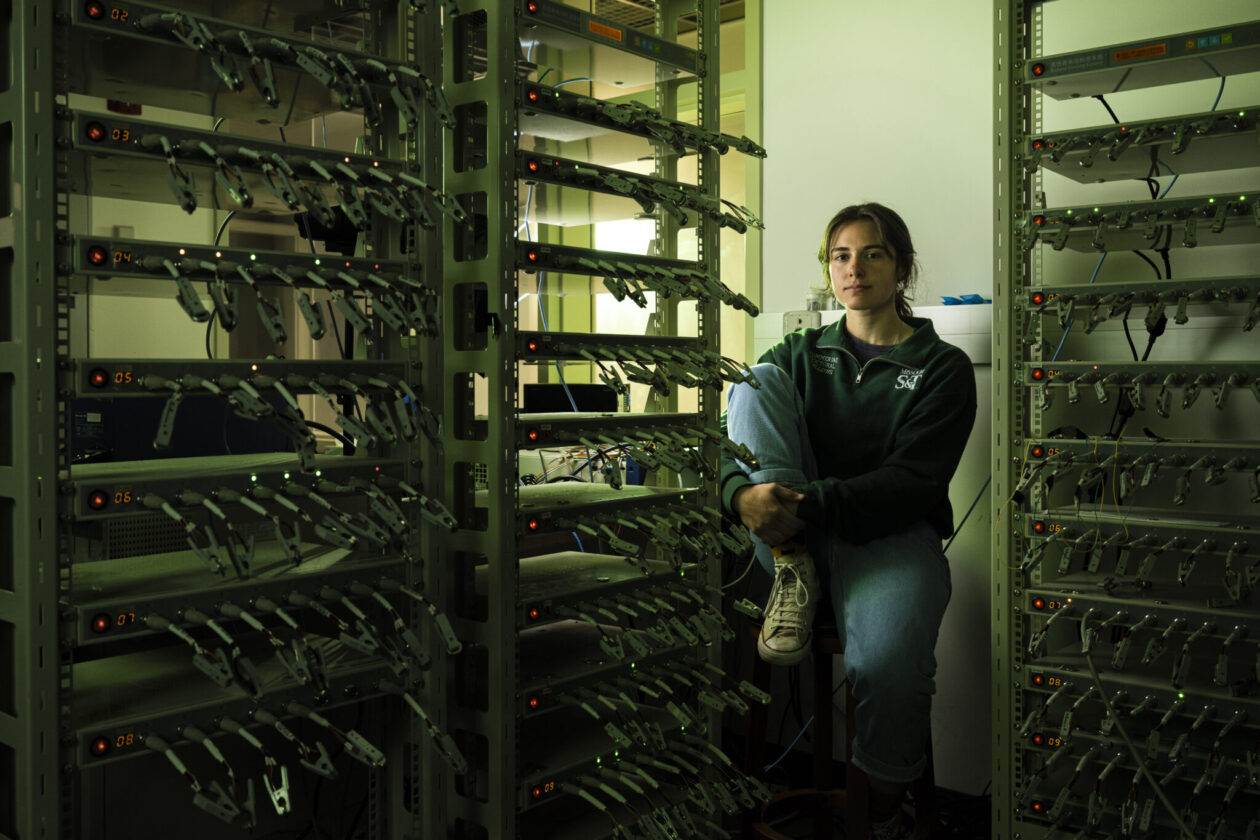Environmentally minded Ph.D. student developing long-last batteries that bring more power to smaller spaces
Posted by Patrick Collins

Gracie Boyer sitting in a Missouri S&T laboratory. Photo by Michael Pierce/Missouri S&T.
When Gracie Boyer was a child, one of the many questions she asked her father, a diesel mechanic, was how their refrigerator worked. After he explained, she had several follow-up questions, including: How would it function if the external temperature was dramatically higher due to the world being on fire? Could an appliance maintain a consistent temperature internally when subjected to extreme fluctuations externally?
A few years later, consumed by curiosity, she disassembled an alternator her father had discarded to learn more about its purpose and function – and whether or not it had a future beyond the scrap pile.
Today, her scenario-based approach to learning serves her well as a Missouri S&T Ph.D. student in mechanical engineering, a Kummer Innovation and Entrepreneurial (I&E) Doctoral Fellow, and an environmentally minded researcher. The fellows program is funded by the $300 million dollar gift the late June and Fred Kummer, a Missouri S&T graduate, made to the university in 2020. Each fellow receives a graduate research assistantship position on campus, a fellowship that’s paid out each semester, tuition remission for required coursework for up to four years and support to offset the costs of professional development.
“I’m still interested in saving the earth,” says Boyer, who grew up in Cadet, Missouri, an unincorporated community in eastern Washington County, “but I don’t think it’s as simple as I used to.”
In 2024, MOREENERGY, a team of S&T students Boyer is a member of, won $75,000 in the Microbattery Design Prize competition sponsored by the Advanced Materials and Manufacturing Technologies Office of the Department of Energy. Along with competitions focused on various sustainability topics, the microbattery challenge was offered through the energy department’s American-Made program, which challenges innovators and entrepreneurs to contribute to clean energy solutions.
S&T’s team proposed a micro battery for hearing aids. The team was one of eight selected to advance to the second phase of the competition to build and test a prototype, conduct a techno-economic analysis, and write a business plan. If the team advances, it will be required to develop an economic viability plan.
“Hearing aid batteries are either disposable, which creates waste, or they have reduced functionality because they’re so small,” Boyer says. “Also, we want to create batteries that let users take advantage of the ways hearing aids are evolving. Some are adding Bluetooth functionality, for example.”
In April 2024, Boyer won first place in the poster competition for S&T’s Graduate Research Showcase for her poster “Enabling Advanced Architectures for Thick and Anode-less Electrodes through Advanced Ultra-Short Laser Micro-Structuring.” She is currently testing using lasers in the development of a battery that creates more energy and lasts longer in spite of its small size.
Boyer says her favorite aspect of the I&E Fellows program is the opportunity to continue the work she started with Dr. Jonghyun Park, associate professor of mechanical and aerospace engineering, who was her advisor while working toward her bachelor’s degree at Missouri S&T, which she earned in 2022.
“I’m very grateful for the continuity from my undergraduate experience to my Ph.D. program,” she says. “I knew going into my doctoral program that I meshed with my advisor, which is important.”
Boyer loves the solitary nature of research, but she also thrives on collaboration. The I&E Fellows program, she says, feels like a perfect combination.
“Research is important to me because it helps me see different parts of mechanical engineering,” she says. “I like to know how things work, and I really like learning in general, which is what I’m getting paid to do every day as an I&E Fellow.”
As important as her lab work is, she relishes being part of the research community fostered by the fellowship program.
“Research can feel really isolating, but when I see what other students in other departments are working on, I see similarities,” she says. “I’m not alone trying to figure something out all on my own.”
Boyer cites the workshops and other networking opportunities made possible by the Kummer Student Programs staff as another advantage of the I&E Fellows program.
“They promote collaboration,” she says. “The workshops and other activities put faces on names of people in other departments. Learning about the work being done in other disciplines gives me ideas for my own research.”
Boyer says one of the benefits of doing research is learning in other areas.
“I knew next to nothing about chemistry or materials science before I started my research,” she says. “Now I know a little more.”
Her work has also inspired her to learn beyond labs and classrooms.
She’s building an A-frame cabin in Ironton, Missouri, with her boyfriend, who earned a mechanical and aerospace engineering degree from S&T. She’s not sure which career path she’ll follow, but she can picture herself living her post-doctorate life there, perhaps consulting remotely for an engineering firm. She’s learning to play banjo. And she rebuilt a transmission from what she refers to as her “collection” of vans.
“I think anybody can learn anything,” she says. “Watch someone who knows what they’re doing and then try. You’re already doing something more than you were before.”
About Missouri S&T
Missouri University of Science and Technology (Missouri S&T) is a STEM-focused research university of over 7,000 students located in Rolla, Missouri. Part of the four-campus University of Missouri System, Missouri S&T offers over 100 degrees in 40 areas of study and is among the nation’s top public universities for salary impact, according to the Wall Street Journal. For more information about Missouri S&T, visit www.mst.edu.
I have often found that being multi-disciplinary leads to “ outside of the box thinking”. Don’t worry what others think of this approach.